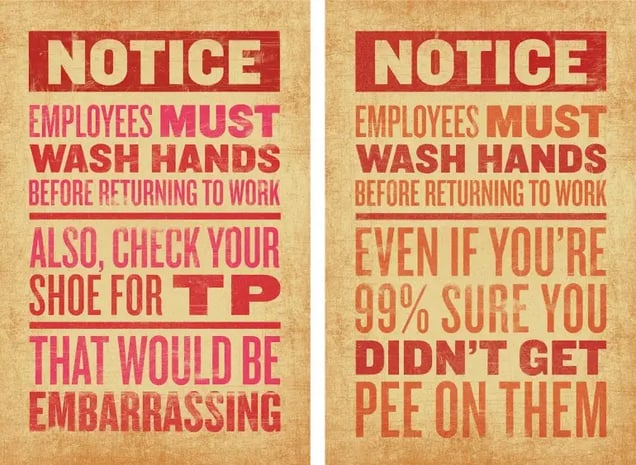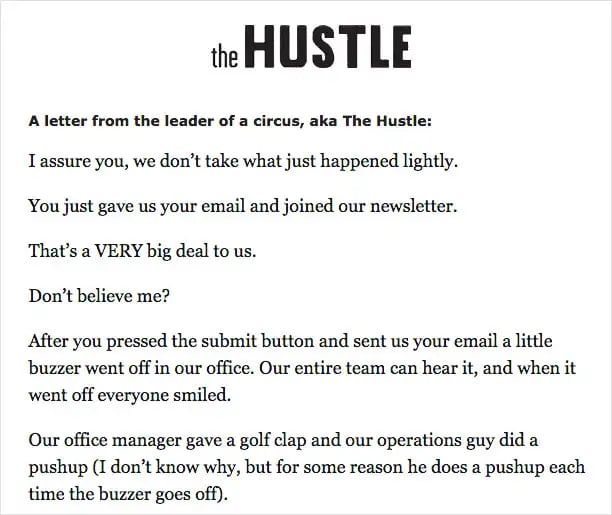“Content is king.”

It’s a phrase you hear all the time. And it’s mostly true — especially in 2016 when we’re consuming so damn much of it.
I mean, just think about the battle for our attention…
The average person spends 8 hours a day consuming some form of media. We’re exposed to tens of thousands of ads every week.
And let’s be honest, after you’re done reading this you’ll probably go check your ad-filled Facebook feed. Then Instagram. Then Snapchat. Then email. Then Netflix.
All of that is content. Every last bit. But, unfortunately for all us hapless consumers, most of it sucks.
Clickbait articles? Awful. Brands trying to be edgy with their “content marketing” and failing miserably? The worst. Pretty much every ad in existence? So bad that our brains are literally trained to tune them out.
So maybe it’s time we made an adjustment to that whole “Content is king” thing. Maybe “Good content is king” would be more accurate?
Or perhaps it’s “Funny content is king.” Yeah, that’s it. That’s the one. BE FUNNY.
Got it? Good. Now let’s teach you how to do it.
Using humor in advertising
DJ O’Neil is the CEO of Hub Strategy & Communication, a San Francisco-based ad agency who works with (or has worked with) the Oakland Athletics, Slingbox, Eat24, Nike, Dropcam, and Jawbone.
Why do these well-known brands trust DJ and his team? Because Hub’s work is injected with a ton of humor and personality. And it works.
“You can either annoy people to sell products or you can entertain them to sell products,” DJ told me. “We take the latter route — specifically humor — because it cuts through the clutter. There’s nothing else like it.”

Sup, Deej?
It’s so true. Just take a look at these advertisements Hub created for Lombardi Sports, a sporting goods store:


Whether or not you need a new snowboard or a pair of running shoes, you can appreciate the humor. And for whatever reason, when an ad makes people laugh, it gives off this vibe of “Oh okay, this company gets it.”
In other words, using humor allows you to say to your target audience,
“Hey! Look, we both know how this game works. We paid money to get this ad in front of you, and our goal is to get you to give us money. Maybe you will, maybe you won’t — hopefully you do! But your time is valuable, so hey, let’s at least make you laugh, right?”
People aren’t stupid. We’re being sold to all day, every day, to the point where we know exactly what’s going on.
Connect on a level beyond the “sale” and you’re golden. Keep it vanilla and you’re toast.
Using humor across your brand (and in unexpected places)
“The great thing about humor is that you can sprinkle it everywhere. Even in stressful situations, it works great. For example, say someone’s credit card is declined on your site. Throw in an automated response that says, ‘Look on the bright side! At least it wasn’t your Passport.’”DJ O’Neil
The world is full of generic, predictable crap. And if you’re smart you can use that to your advantage.
See, people become so accustomed to bland, lifeless brand interactions, that doing something different in those situations makes 20x the impact.
For example
You know those boring “Employees must watch hands before returning to work” bathroom signs? I doubt many businesses view that as a piece of content, but considering how many customers see it, maybe they should.
Here’s what Hub did for Chevy’s Fresh Mex:

Since your brain’s not expecting any creativity here, you’re all the more receptive when you see it. It sticks with you. And again, it says, “This place gets it. We’d probably be friends.”
We try to do this, ourselves, actually.
As anyone who’s signed up for our newsletter knows, we send a pretty ridiculous welcome email that people routinely shout out online.
Don’t want to ruin it for all you noobs (sign up, damn it), so you don’t get the full thing. But here’s how it starts:

Most welcome emails are more along the lines of, “Thank you for signing up!” or “You have successfully subscribed!” How boring is that? Tells the audience nothing about the brand. Causes zero emotional reaction.
Stand out in unique places — places your competitors aren’t even thinking about — and you will reap the benefits.
Get weird in the Facebook comments section. Make your FAQ page hilarious. Send GIFs as a part of your automated email responses.
Once you realize that everything is content and that every single interaction a user has with your brand is technically “advertising,” you’re getting places.
Is humor ever not effective?
Good question, intelligent reader. As DJ told me, “If you run a chain of funeral homes, there might not be room for humor. But outside of that, there almost always is.”
If you’re a bank, a law firm, or any other “boring” business, nothing’s stopping you from being funny. Heck, Hub did some work for Blue Shield (an insurance company) and it’s hilarious.
And think back to Virgin America’s viral “tray tables up” safety video. Also LOL worthy.
Sure, it’s definitely hard to be funny when customers are expecting you to be super professional and boring, but guess what? Life is hard. Stop complaining.
Plus, the less “funny” your industry is, the more you’ll stand out when you make people laugh.
Just look at GEICO. Sales rocketed when they started making ridiculous ads, and next thing you know, every auto insurance commercial on TV is a comedy fest (not gonna lie, I hate Flo, though).
Nobody’s ever going to think to themselves, “Wow, this bank is not being very serious or professional! How embarrassing.” Rather, they’ll think, “Wow, these guys are so good at what they do that they can even add a level of humor! How impressive.”
In conclusion
Using humor can feel risky. And since most people are risk averse, they shy away from it. I get that.
But as DJ says, “Humor isn’t risky. Everyone appreciates a good laugh. Keeping things super straightforward and bland? Now that’s risky. Why? Because nobody’s going to see it.”
Be funny and stand out or be boring and fall through the cracks. The choice is yours.
Watch DJ’s talk at FunnyBizz to learn more about his approach to selling stuff through humor.
Also, if you’re interested in learning more about creating epic (and funny) content, snag a ticket to our newest event, Con Con, which is happening on November 4th in San Francisco.

